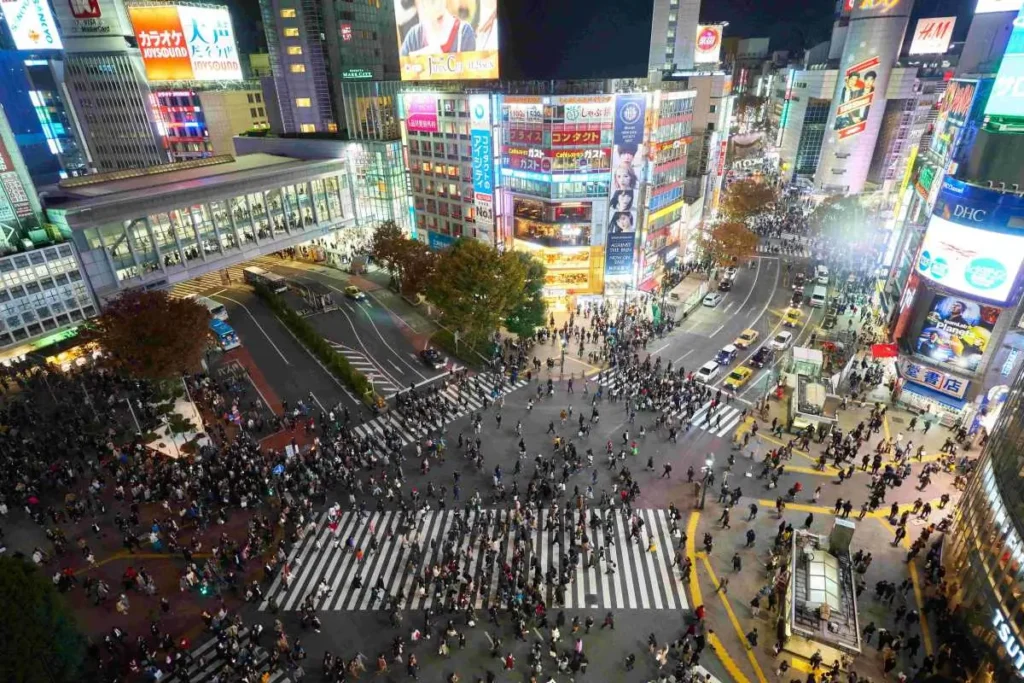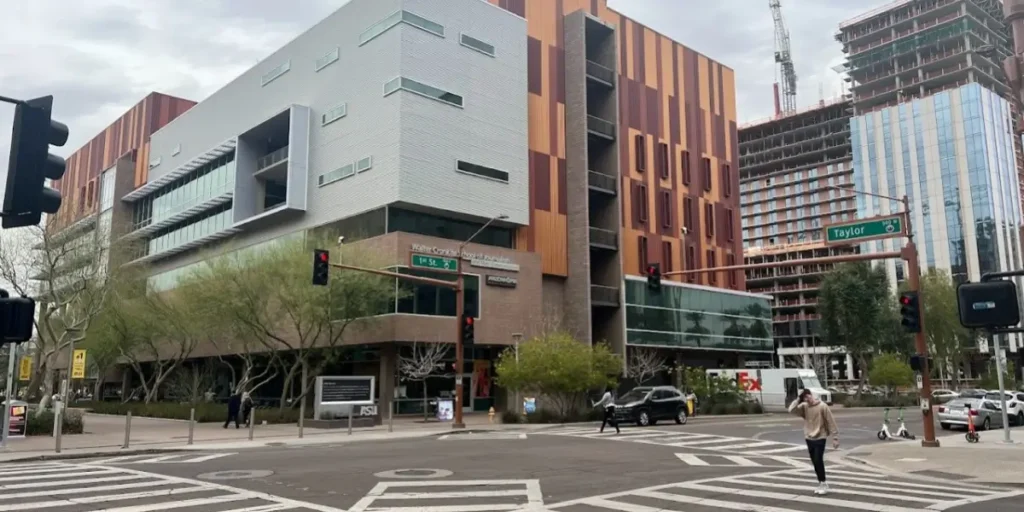What is a pedestrian scramble crossing?
A pedestrian scramble, also known as an exclusive pedestrian crossing, is a light cycle that stops all vehicular traffic to allow only pedestrians to cross in any direction at an intersection. Such crossings are generally employed in areas with high pedestrian traffic, such as downtowns and college campuses. You may have heard of the Shibuya Crossing in Tokyo, which is the most famous example of a pedestrian scramble, and at the busiest times, it is estimated that 1,000 to 2,500 people cross this intersection every two minutes! On the busiest days of the year, it can be as high as 500,000 people crossing a day. That is similar to the entire population of the City of Atlanta crossing one intersection every day.

Cracking the historic egg on scramble crossings
The concept of scramble crossings was popularized by Henry Barnes, a traffic engineer who served as the traffic commissioner in several major cities in the mid-20th century. The scramble crossing, known as the Barnes Dance, was first used throughout the 1940s and later popularized by Henry Barnes in the years after. He never claimed to have created the scramble but was a major influence and promoter of it. In his autobiography, The Man With the Red and Green Eyes, he stated, “There were a few such installations in Kansas City, Vancouver, and a couple of other cities. But we would put them throughout the entire business area” (Barnes 110).
There is evidence of a type of scramble crossing that predates the 1940s emergence of what we now consider a scramble crossing. Dr. John Harriss, a former Special Deputy Police Commissioner in charge of traffic (1918-1926), created a system that included four phases:

- Vehicular traffic moves north and south.
- Pedestrian traffic moves in all directions.
- All traffic waits while pedestrians clear the intersection.
- Pedestrians wait until vehicular traffic moves on the cross street.
Dr. John Harriss implemented phase 2 of the system, which we would now call the ‘scramble crossing.’ It was essential because it allowed pedestrian traffic to move in all directions while cars were prohibited from moving, even on red. This restriction remained in effect until after phase 3, at which point traffic had to wait for pedestrians to clear the intersection.
Benefits of a scramble crossing
By giving pedestrians the exclusive right of way for a brief period, scramble crossings enhance safety and reduce the risk of accidents. The synchronized flow of foot traffic reduces conflicts between pedestrians and vehicles, creating a safer environment for all road users. In one study done in Oakland’s Chinatown, it was found that the pedestrian scramble had the effect of decreasing the conflict rate at the intersection by almost 50% (Bechtel et al.). The study also looked at findings by Zaidel and Hocherman and Zegeer et al., who also found the scramble crossing to be advantageous at locations with high volumes of both pedestrians and vehicles. There is concern, as always, about traffic flow; however, a study found that scramble crossings can reduce vehicle delay significantly, by up to 35.74%, compared with normal pedestrian crossings (Trần Vũ Tự and Sano 2014).

Here are a few more benefits I found through researching the topic:
- Enhanced Pedestrian Safety: With cars required to stop in all directions and give a clear path to pedestrians, there is a reduced chance of conflict between cars and people crossing the street.
- Increased Pedestrian Convenience: Saving time by only needing to cross the street once can be more convenient for pedestrians. In cases where these are placed in college areas, students can benefit by making it across campus more quickly.
- Promotions better usage of public transportation: Safer and more convenient connections to buses or trains encourage more usage, especially if one had to double cross for a transit connection and now the intersection has a scramble.
- Economic Benefits: Increased pedestrian flow and safety tend to lead to increased foot traffic for nearby businesses.
Here are a few drawbacks from scramble crossings:
- Confusion Among Road Users: Drivers, pedestrians, and cyclists unfamiliar with scramble crossings may experience confusion, particularly in areas where such crossings are not common, which could temporarily decrease safety until users adapt to the new system.
- Inefficiency in Low Pedestrian Areas: In locations where pedestrian volumes are low, scramble crossings may not be as efficient as standard crossings since they can unnecessarily delay vehicles without significant benefits for pedestrian movement.
- Potential for Increased Traffic Congestion: Scramble crossings may extend the waiting period for vehicles, potentially leading to increased traffic congestion. Although the study by Trần Vũ Tự and Sano (2014) challenges this notion, it is conceivable that in areas with scant pedestrian traffic or where a scramble crossing is illogical, the potential for increased congestion exists. It reality, it really depends on the priority of the city and if they care more about traffic flow or the safety of its citizens.
But fear not, our glorious government reported to Congress in August 2008, stating, “However, a rigorous comparison of the pedestrian crash experience between exclusive pedestrian phases and systems that permit parallel traffic to turn across crosswalks during the walk phase of the pedestrian signal could not be found” (“Pedestrian Safety Strategic Plan“). I am not sure how a pedestrian crashes into a car, but these are the kind folks who are building and giving advice on how to build our streets. Government and traffic engineers seem not to mind scapegoating their consequences of traffic input over the lives of pedestrians by placing blame on pedestrians wherever possible. Unless Superman is real, there is no human in the world capable of crashing from walking. A car is physically bigger and more powerful; there is a power dynamic that leaves no room to justify a person walking that is a “pedestrian crashing” into a car. With great power comes great responsibility, and this is most true when reflecting on yourself as a driver on the road. You have the most power to destroy the surrounding area, and you must have the most responsibility.
Scramble crossing everywhere and NOW!
Scramble crossings are great, but they are a tool we can use to help shape our urban environment and create a better space for everyone. As an urban area develops and grows with pedestrian volumes, it reaps more of the scramble crossing’s benefits. There is a time and a place to use a scramble crossing; it is important to note other options when weighing changes to make that can still greatly benefit pedestrians. Another one, and possibly I could dive deeper in another post, is having leading pedestrian intervals (LPIs). We should not rule any options of the table when it comes to improvements to our urban areas. In some cases, a full pedestrianize street may be the best solution in some case for both pedestrian and drivers.
References
- Barnes, Henry A. The Man with the Red and Green Eyes. E. P. Dutton and Company, 1965.
- Bechtel, A. K., MacLeod, K. E., and Ragland, D. R. Oakland Chinatown Pedestrian Scramble: An Evaluation. 2003. eScholarship, https://escholarship.org/uc/item/3fh5q4dk.
- “Pedestrian Safety Strategic Plan: Background Report – Chapter 3.” Federal Highway Administration, U.S. Department of Transportation, 2008, https://safety.fhwa.dot.gov/ped_bike/legis_guide/rpts_cngs/pedrpt_0808/chap_3.cfm.
- Trần, Vũ Tự, and Sano Kazuya. “Simulation Based Analysis of Scramble Crossings at Signalized Intersections.” International Journal of Transportation, vol. 2, no. 2, 2014, https://dx.doi.org/10.14257/IJT.2014.2.2.01.
- “Walking: It’s a Right, Not a Privilege.” Federal Highway Administration, U.S. Department of Transportation, https://www.fhwa.dot.gov/infrastructure/walk01.cfm.



